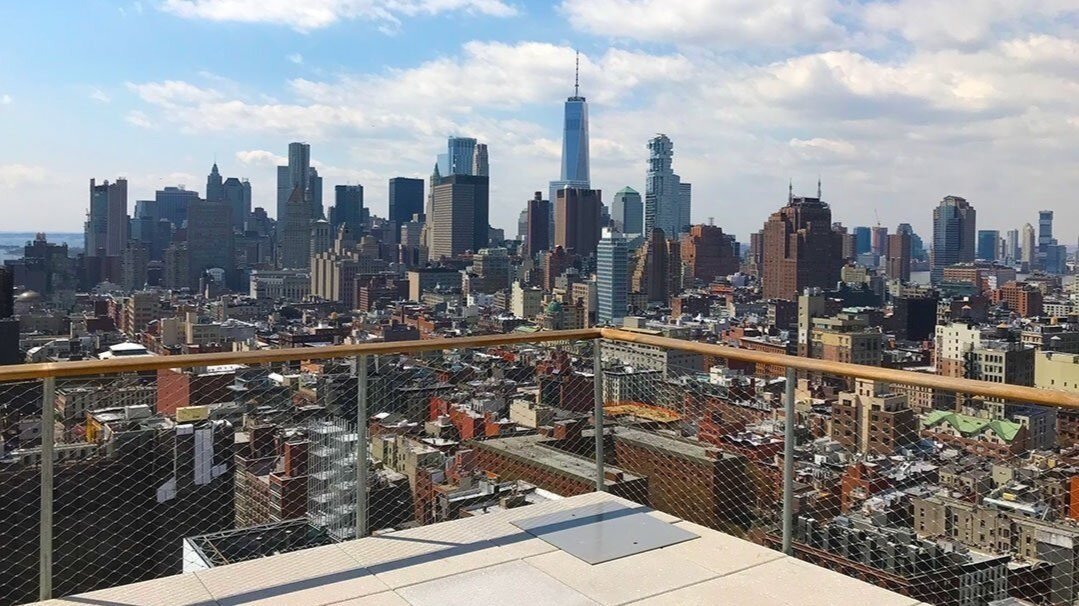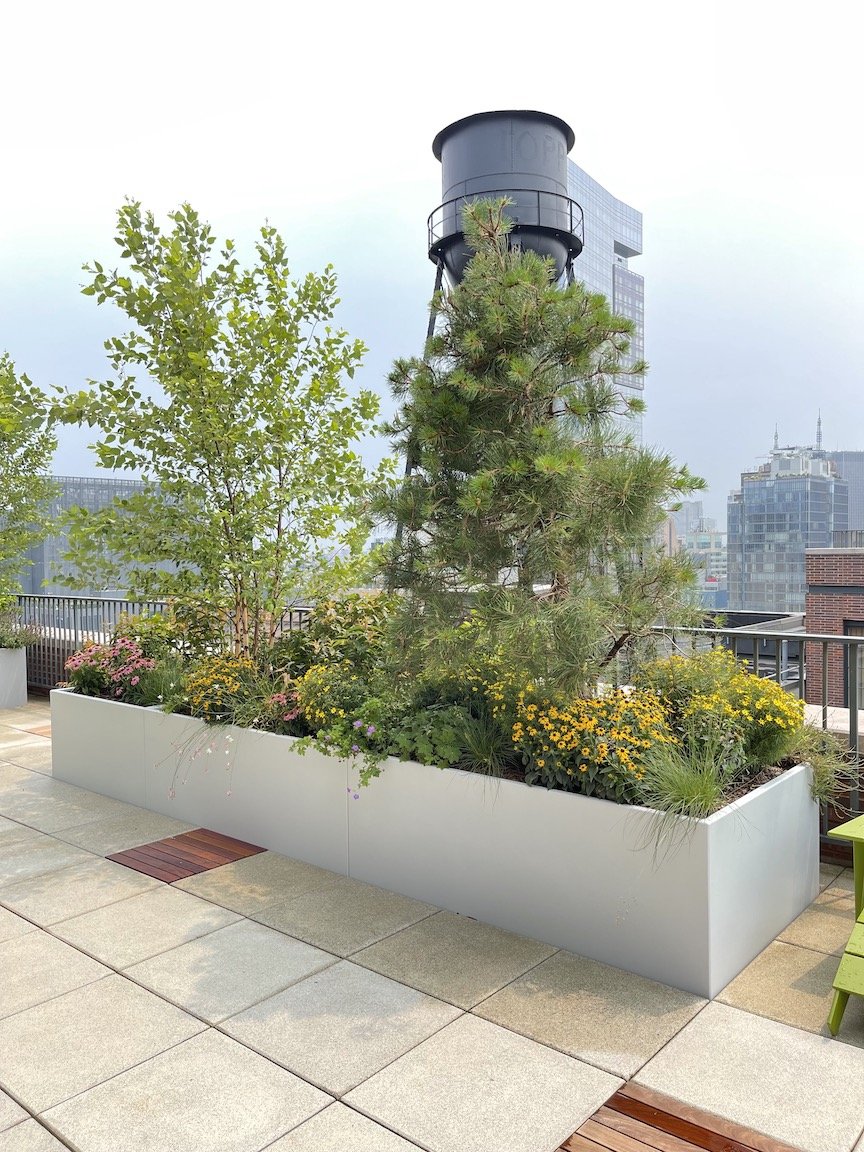Private outdoor space has become a prized amenity and is often a requirement in searches on the New York City housing market. The Covid-19 pandemic highlighted the importance of outdoor spaces for both physical and mental well-being. As people began spending more time at home, demand for private outdoor space surged. When looking for ways to be with loved ones, private outdoor space offered people a chance to entertain without begin stuck in close quarters together.
Incredible view and a blank slate for the garden
Rooftops and terraces offer their owners real benefits for their quality of life. What better way to unwind after a day of work than to relax on a rooftop terrace, surrounded by greenery and amenities of your choice? A rooftop garden can range from simple to luxurious, allowing you to incorporate features such as a pergola, fountains, outdoor kitchens, sculpture, or even a television.
Creating a garden within the urban infrastructure can take extraordinary measures to accomplish. Producing an outdoor space that is beautiful, structurally sound, and resilient in harsh weather conditions is a collaborative process. A well-designed, multi-functional rooftop or terrace garden likely involves collaborating with a structural engineer, a landscape designer, and multiple specialized contractors.
This Greenwich Village terrace came into being after months of collaboration.
Before you can relax, dine, and entertain from your rooftop oasis, keep these SEVEN important practical considerations in mind.
1. Learn your building’s regulations and rules for renovations
Regulations defining the establishment of rooftop gardens are unique to each condominium or cooperative’s board and management. Check with your board before proceeding. Depending on the scope of your project, your building may require an Alteration Agreement, which is a contract between an individual apartment owner and their building board. The Alteration Agreement outlines the building rules, requirements, responsibilities, and expectations for the owner and board throughout the renovation process.
2. Inspect your roof - your garden’s floor
Hire an engineer to survey your space and inspect your roofing membrane. They should be on the look out for water damage, any openings in the roof membrane, and areas of ponding. You’ll want to address these problems before installing a new deck or pavers. You want to be sure that your garden will not cause water leaks or strain the roof’s foundation.
The interstitial space between roof pavers and roof slab/waterproofing.
3. Weight limits on your rooftop garden
Understand what the maximum weight load is per square foot as designed for your roof. Consult with a structural engineer to determine the live load, which is how much weight the roof can hold after factoring in rain or snow. Once you know the live load, your landscape designer can design the space based on calculations of how much weight the roof can support, and how the weight should be distributed. Planter boxes with wet soil can become extremely heavy and surpass building weight limits. Finding a way to minimize the total weight of a planter, while at the same time providing sufficient growing medium for plants is challenging, but critical. Landscape designers achieve this balance by selecting lightweight soil mixes and using styrofoam to bottom fill planters that are generally taller than 24 inches. Purchasing fiberglass planters or aluminum planters will always be lighter than those created from wood or concrete.
4. Wind conditions on your rooftop garden
Consult with a structural engineer about wind loads for your rooftop. Spend time on your rooftop on a windy day and assess how wind and light create microclimates. Different areas of the rooftop may experience varying wind speeds and directions. Plants that require a more sheltered habitat should be placed near building walls. In more exposed areas that will be hit harder by wind, plant species that are adapted to harsh coastal or montane climates. Examples of such species are Pinus rigida (Pitch Pine), Pinus strobus (White Pine), Prunus maritima (Beach Plum), and Myrica pennsylvanica (Northern Bayberry).
If you’re planning to install a fence, choose one that has small gaps to filter wind. A solid fence acts as a barrier that obstructs the flow of wind. When wind encounters a solid surface, it creates resistance, leading to increased pressure on the windward side and turbulence on the leeward side. This can result in strong forces that may cause the fence to sway, vibrate, or even topple over. The gaps between fence slats don’t need to be large, less than half an inch. This style of fence preserves privacy while allowing wind to pass through. Your fence will need to be secured to the building structurally.
Consider the stability of every item on the rooftop. Avoid pedestal style planters that are tall and narrow - they will tip over. Planters can be bolted together to prevent overturning. Trees can be secured to a wall or larger structure using guy wires and cabling. Secure furniture with discreet cables disguised by the roof tiles. If securing all your furniture to the roof is not desirable, incorporate lightweight folding furniture that can be stored during periods of high winds.
5. Screening views for privacy and to hide any eyesores
Your rooftop garden will probably have views you want to preserve and views you would prefer to mask. Masking mechanicals has been important to every client with a roof garden project. You can use both plants and hardscaping to hide unsightly venting and air conditioner condensers. A slotted fence with gaps can hide mechanicals while also acting as a windbreak. A metal panel with laser cut designs would serve the same purpose while also being decorative. You can also use plants to mask the mechanicals, provided they are planted with an appropriate clearance for airflow from the mechanicals. Native grasses found in prairies (such as Andropogon gerardii) or coastal plains (for example, Sorghastrum nutans) are appropriate choices.
If you need to create privacy from neighbors, you can use a combination of slotted fencing and plants. Rather than lining your entire roof with a hedge, you can place a row of shrubs or grasses directly in the line of sight of neighboring windows. This creates privacy while preserving a sense of openness. To create privacy from buildings that can look down onto your garden, you can use a combination of umbrellas, shade sails, and a pergola to conceal the view into your garden from above.
6. Irrigation - nurture your plants in their new home
Understand that the more exposed your terrace garden is, the hotter and windier it will be. Along with that, your plants will encounter severe desiccation. You will likely need to water twice a day in mid-summer. The most important investment for your plants is a drip irrigation system. These systems come with timers that allow you to set a watering schedule for your plants, which can be changed according to the season. Although you can still hand-water on days when you have time, the irrigation system will ensure that you don’t have to plan your days and vacations around your garden’s watering needs. Keep the ground layer of your planters dense with plants. This will preserve soil moisture while also maintaining a rich soil nutrient cycle.
7. Safety - make your time outside stress-free
Lastly, but certainly of great importance, confirm that parapet edges and railings are a minimum height of 42” from grade. If you have young children, consider purchasing planters that are the same height of the parapet edge. This would prevent the planter from becoming a step or booster for young climbers. Avoid placing furniture at the parapet edge, for the same safety reason. Since the last thing you want is to have an airborne umbrella, be sure to secure umbrellas and other shade structures to the roof slab.
Concluding Thoughts on Designing a Rooftop Garden in New York City
Designing a rooftop garden requires taking into account several practical factors, including weight load specifications, weather conditions, and adherence to city codes and permits. Additionally, a careful design process is essential for creating a rooftop that incorporates attractive plantings, preserves desirable views, creates privacy, and provides inviting spaces for dining, entertaining, and relaxing.





